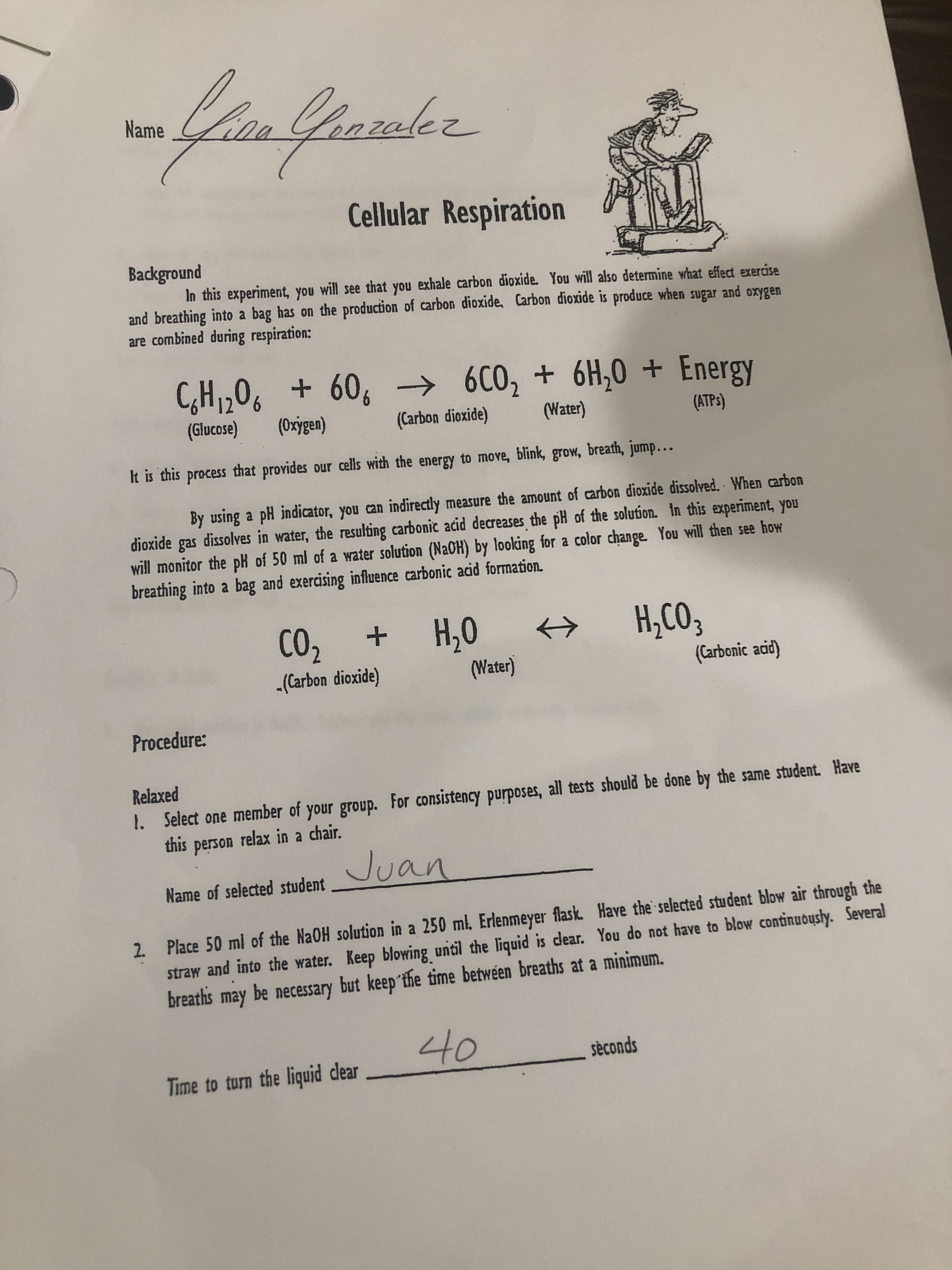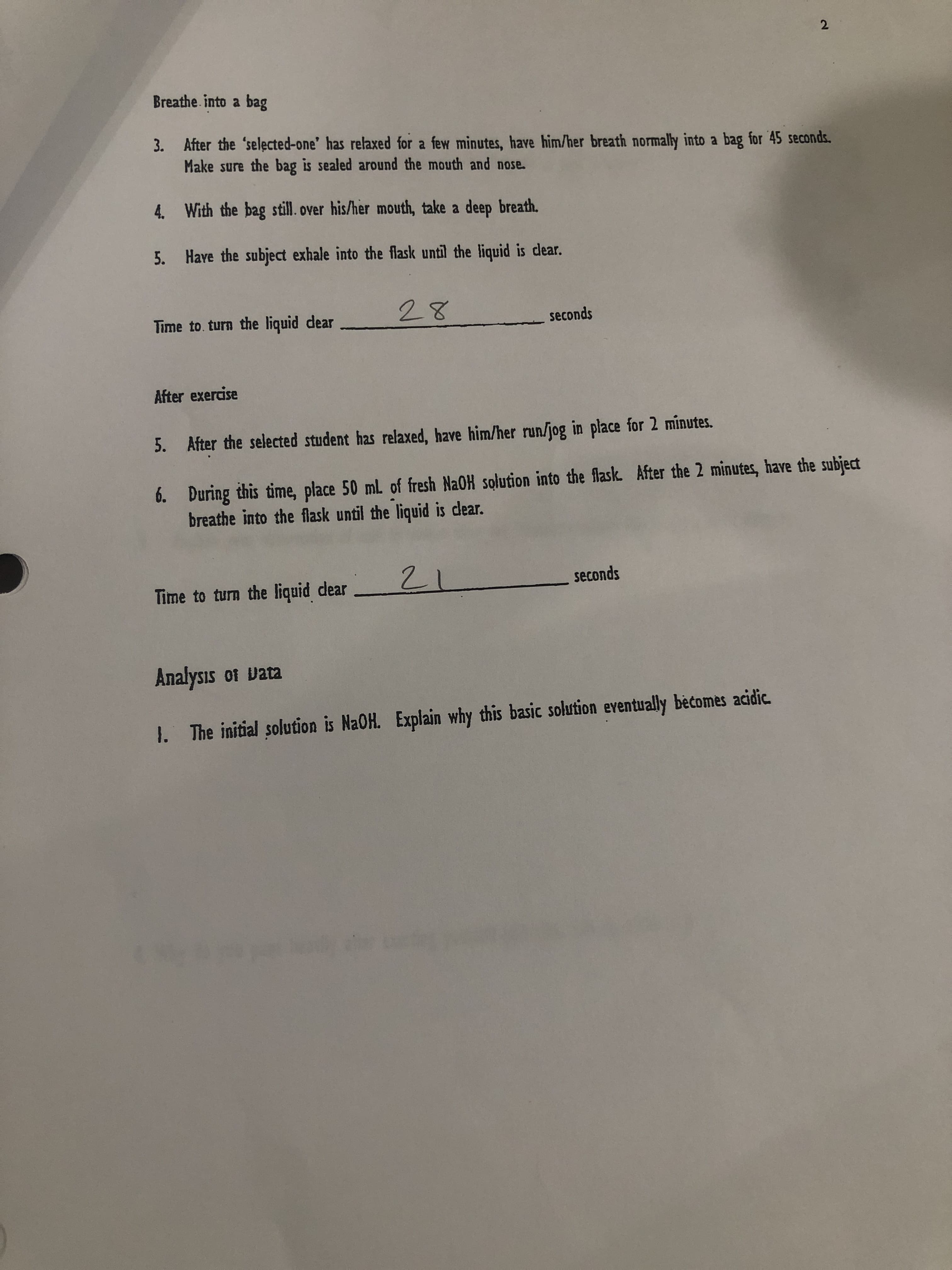zalez Name Cellular Respiration Background In this experiment, you will see that you exhale carbon dioxide. You will also determine what effect exercise and breathing into a bag has on the production of carbon dioxide, Carbon dioxide is produce when sugar and oxygen are combined during respiration: 6C02 +6H,0+Energy +60, 12 (Glucose) (0xygen) (ATPS) (Water) (Carbon dioxide) It is this process that provides our cells with the energy to move, blink, grow, breath, jump... By using a pH indicator, you can indirectly measure the amount of carbon dioxide dissolved. When carbon dioxide gas dissolves in water, the resulting carbonic acid decreases the pH of the solution. in this experiment, you will monitor the pH of 50 ml of a water solution (Na0H) by loolking for a color change. You will then see how breathing into a bag and exercising infuence carbonic acid formation. Н, СО, H.CO3 H2O (Water) C02 + (Carbonic acid) -(Carbon dioxide) Procedure: Relaxed 1. Select one member of your group. For consistency purposes, all tests should be done by the same student. Have this person relax in a chair. Juan Name of selected student 2. Place 50 ml of the NaOH solution in a 250 ml. Erlenmeyer flask. Have the selected student blow air through the straw and into the water. Keep blowing until the liquid is dear. You do not have to blow continuously. Several breaths may be necessary but keep the time betwen breaths at a minimum. 40 seconds Time to turn the liquid dear 2 Breathe into a bag 3. After the 'selected-one' has relaxed for a few minutes, have him/her breath normally into a bag for 45 seconds. Make sure the bag is sealed around the mouth and nose. 4. With the bag still. over his/her mouth, take a deep breath. 5. Have the subject exhale into the flask until the liquid is dlear. 28 Time to. turn the liquid dear seconds After exercise 5. After the selected student has relaxed, have him/her run/jog in place for 2 minutes. During this time, place 50 ml. of fresh NaOH solution into the flask. After the 2 minutes, have the subject breathe into the flask until the liquid is dear. 6. 21 seconds Time to turn the liquid dear Analysis of vata I. The initial solution is NaOH. Explain why this basic solution eventually becomes acidic.
zalez Name Cellular Respiration Background In this experiment, you will see that you exhale carbon dioxide. You will also determine what effect exercise and breathing into a bag has on the production of carbon dioxide, Carbon dioxide is produce when sugar and oxygen are combined during respiration: 6C02 +6H,0+Energy +60, 12 (Glucose) (0xygen) (ATPS) (Water) (Carbon dioxide) It is this process that provides our cells with the energy to move, blink, grow, breath, jump... By using a pH indicator, you can indirectly measure the amount of carbon dioxide dissolved. When carbon dioxide gas dissolves in water, the resulting carbonic acid decreases the pH of the solution. in this experiment, you will monitor the pH of 50 ml of a water solution (Na0H) by loolking for a color change. You will then see how breathing into a bag and exercising infuence carbonic acid formation. Н, СО, H.CO3 H2O (Water) C02 + (Carbonic acid) -(Carbon dioxide) Procedure: Relaxed 1. Select one member of your group. For consistency purposes, all tests should be done by the same student. Have this person relax in a chair. Juan Name of selected student 2. Place 50 ml of the NaOH solution in a 250 ml. Erlenmeyer flask. Have the selected student blow air through the straw and into the water. Keep blowing until the liquid is dear. You do not have to blow continuously. Several breaths may be necessary but keep the time betwen breaths at a minimum. 40 seconds Time to turn the liquid dear 2 Breathe into a bag 3. After the 'selected-one' has relaxed for a few minutes, have him/her breath normally into a bag for 45 seconds. Make sure the bag is sealed around the mouth and nose. 4. With the bag still. over his/her mouth, take a deep breath. 5. Have the subject exhale into the flask until the liquid is dlear. 28 Time to. turn the liquid dear seconds After exercise 5. After the selected student has relaxed, have him/her run/jog in place for 2 minutes. During this time, place 50 ml. of fresh NaOH solution into the flask. After the 2 minutes, have the subject breathe into the flask until the liquid is dear. 6. 21 seconds Time to turn the liquid dear Analysis of vata I. The initial solution is NaOH. Explain why this basic solution eventually becomes acidic.
Biology: The Dynamic Science (MindTap Course List)
4th Edition
ISBN:9781305389892
Author:Peter J. Russell, Paul E. Hertz, Beverly McMillan
Publisher:Peter J. Russell, Paul E. Hertz, Beverly McMillan
Chapter7: Cellular Respiration: Harvesting Chemical Energy
Section: Chapter Questions
Problem 13TYK: 13. There are several ways to measure cellular respiration experimentally. For example, CO2 and...
Related questions
Question
I need help with this lab. How do i answer question 1?

Transcribed Image Text:zalez
Name
Cellular Respiration
Background
In this experiment, you will see that you exhale carbon dioxide. You will also determine what effect exercise
and breathing into a bag has on the production of carbon dioxide, Carbon dioxide is produce when sugar and oxygen
are combined during respiration:
6C02 +6H,0+Energy
+60,
12
(Glucose)
(0xygen)
(ATPS)
(Water)
(Carbon dioxide)
It is this process that provides our cells with the energy to move, blink, grow, breath, jump...
By using a pH indicator, you can indirectly measure the amount of carbon dioxide dissolved. When carbon
dioxide gas dissolves in water, the resulting carbonic acid decreases the pH of the solution. in this experiment, you
will monitor the pH of 50 ml of a water solution (Na0H) by loolking for a color change. You will then see how
breathing into a bag and exercising infuence carbonic acid formation.
Н, СО,
H.CO3
H2O
(Water)
C02
+
(Carbonic acid)
-(Carbon dioxide)
Procedure:
Relaxed
1. Select one member of your group. For consistency purposes, all tests should be done by the same student. Have
this person relax in a chair.
Juan
Name of selected student
2. Place 50 ml of the NaOH solution in a 250 ml. Erlenmeyer flask. Have the selected student blow air through the
straw and into the water. Keep blowing until the liquid is dear. You do not have to blow continuously. Several
breaths may be necessary but keep the time betwen breaths at a minimum.
40
seconds
Time to turn the liquid dear

Transcribed Image Text:2
Breathe into a bag
3. After the 'selected-one' has relaxed for a few minutes, have him/her breath normally into a bag for 45 seconds.
Make sure the bag is sealed around the mouth and nose.
4. With the bag still. over his/her mouth, take a deep breath.
5. Have the subject exhale into the flask until the liquid is dlear.
28
Time to. turn the liquid dear
seconds
After exercise
5. After the selected student has relaxed, have him/her run/jog in place for 2 minutes.
During this time, place 50 ml. of fresh NaOH solution into the flask. After the 2 minutes, have the subject
breathe into the flask until the liquid is dear.
6.
21
seconds
Time to turn the liquid dear
Analysis of vata
I. The initial solution is NaOH. Explain why this basic solution eventually becomes acidic.
Expert Solution
This question has been solved!
Explore an expertly crafted, step-by-step solution for a thorough understanding of key concepts.
This is a popular solution!
Trending now
This is a popular solution!
Step by step
Solved in 2 steps

Knowledge Booster
Learn more about
Need a deep-dive on the concept behind this application? Look no further. Learn more about this topic, biology and related others by exploring similar questions and additional content below.Recommended textbooks for you

Biology: The Dynamic Science (MindTap Course List)
Biology
ISBN:
9781305389892
Author:
Peter J. Russell, Paul E. Hertz, Beverly McMillan
Publisher:
Cengage Learning

Biochemistry
Biochemistry
ISBN:
9781305577206
Author:
Reginald H. Garrett, Charles M. Grisham
Publisher:
Cengage Learning


Biology: The Dynamic Science (MindTap Course List)
Biology
ISBN:
9781305389892
Author:
Peter J. Russell, Paul E. Hertz, Beverly McMillan
Publisher:
Cengage Learning

Biochemistry
Biochemistry
ISBN:
9781305577206
Author:
Reginald H. Garrett, Charles M. Grisham
Publisher:
Cengage Learning


Biology (MindTap Course List)
Biology
ISBN:
9781337392938
Author:
Eldra Solomon, Charles Martin, Diana W. Martin, Linda R. Berg
Publisher:
Cengage Learning

Human Biology (MindTap Course List)
Biology
ISBN:
9781305112100
Author:
Cecie Starr, Beverly McMillan
Publisher:
Cengage Learning